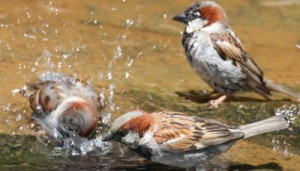 Planting flowers in your yard can contribute more than just a beautiful landscape. The flowers you plant can also draw welcome visitors. Hummingbirds just returning from their winter migration, butterflies and song birds and small year-round birds will all be attracted to the flowers in your garden and to the seeds they produce.
Planting flowers in your yard can contribute more than just a beautiful landscape. The flowers you plant can also draw welcome visitors. Hummingbirds just returning from their winter migration, butterflies and song birds and small year-round birds will all be attracted to the flowers in your garden and to the seeds they produce.
If you want to attract these creatures to your garden, it is better not to use any toxic pesticides or other harmful chemicals. You want these creatures to thrive by visiting your garden.
Native plants may be ones the local fauna are accustomed to feeding on. But they may also welcome other species that provide nourishment. Consult your local agricultural extension office about bushes to plant that provide berries the birds like, and other things you can plant that provide both cover and food for wildlife.
If you have a bird feeder, you get great enjoyment watching the birds that come to it. But try to put the feeder in a location close to dense shrubs or trees such as spruce that provide protective cover to the small birds. If a hawk appears, the birds will need a place they can get to quickly to keep them out of reach of the hawk.
Also, you may want to provide nesting places for birds you especially want to attract, such as the bluebird. Phoebes are a small bird that likes to nest in the eaves of a house. If you provide a place for it, it will cut down on the mosquito population in your yard all summer.
Hummingbirds and butterflies seek flowers with nectar. Lilac bushes provide this, as do many other flowering shrubs and many types of flowers. Bees seek the same kinds of flowers, but also will visit the blossoms on your squash plants and other vegetables with blossoms, helping pollinate them.
Try to plant flowers that bloom in early spring, followed by flowers that bloom in early summer, then later summer, and even into the fall. This will provide a constant supply of nectar, and keep the hummingbirds and butterflies visiting your yard.
Plant giant sunflowers in your yard and you are sure to make the chickadees happy. You may even be able to harvest some of the seeds to put in your birdfeeder during the winter. The rosehips on rugosa roses provide nutritious food for birds. Flowers such as echinacea produce seed heads, as do many other summer flowers. These will provide food for the birds if you let the seeds ripen. After the seeds fall to the ground, the chipmunks and other small creatures will enjoy them.
Gather for yourself some of the seeds from this year’s flowers, so you can plant them next year. You will spend a lot less money at the nursery next year!
Colorful flowers draw colorful birds and butterflies to your garden, bringing enjoyment to your summer. These creatures also help spread seeds and help pollinate plants. They are part of the cycle of nature. By including plants that give food to these small visitors, you will be helping keep them flourishing.








